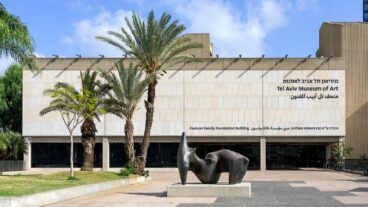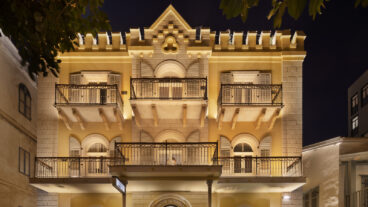Yair Gil doesn’t look like a daredevil and if you ask him, he isn’t. On July 7, 2008, Gil set out on a well-thought out trip of a lifetime, flying a Cozy Mark IV aircraft that he built himself across the Mediterranean basin. If all goes according to plan, in under three weeks Gil will land in Oshkosh, Wisconsin, to attend the Experimental Aircraft Association’s Fly-In Convention, also known as EAA AirVenture Oshkosh. When he lands, he’ll be the first person to fly from the Middle East to the US in a homebuilt aircraft, setting a new world record for the Cozy MK IV.
Speaking to ISRAEL21c from the island of Corsica on third day of his trip, Gil said that the trip was “going more or less fine. The first day was really good – we thought to fly to Rhodes but decided to continue on to Corfu. The second day was a bit rough – it was over the sea and I was fighting 100km per hour winds. I thought I had fuel for 6 hours but I had to stop in Salerno. Then on to Corsica – it took 6 hours in the air, plus the stop. Today I rest and tomorrow go on.”
Gil’s route takes him from Ajaccio, Corsica to La Manche, France; Wick, Scotland; Keflavik, Iceland; Narsarsuaq, Greenland and on to Northern Canada. He’ll then fly southwards along the Hudson Bay to his final destination.
“I promised the gang at Oshkosh that when it was ready I’d fly there, so I’m doing that,” says Gil. “It” refers to the Cozy MK IV, a single engine, homebuilt 4-seater, light aircraft designed by Nat Puffer of Arizona. The aircraft is constructed from foam and fiberglass and can cruise at up to 180-190 knots. Puffer’s Cozy (originally based on the Long-EZ aircraft, designed by legendary aerospace engineer Burt Rutan) has cult status among those who choose to devote 10 years to the hobby – including websites, chat room forums and annual gatherings. The Cozy is not sold as a kit; rather, pilots and would-be pilots purchase plans and information from Puffer’s company, Co-Z Development, and build it from the ground up. This leaves the field wide open to modifications — and lots of discussion about modifications – a perfect fit for aircraft buffs.
“I belong to a group of people from around the world, mostly from the US,” says Gil. “We buy the plans and build the plane from scratch. There are about 1,300 sets of plans that have been sold and about 350 Cozy MK IV around the world. I’ve been to Oshkosh 13 times but only in 2003, did I decide — after a debate on the Internet — to build the plane.”
Gil says he had a different approach to the project. “In the US, they build the Cozy as minimalistically as possible. Let’s say the plane I made has whipped cream and a cherry on top. And I built it very quickly, in three and a half years, including half a year off with a shoulder injury. This is the first ‘built from scratch’ 4-seater fiberglass aircraft. The frame is encased in a fiberglass layers coating, polystyrene foam, PVC, and other materials. But the main thing in my plane is the equipment – there’s a lot of equipment installed – my control panel has the best technology available as of two years ago. I invested everything in the instrument panel.”
One major modification Gil made for his trip was to remove 3 of the four seats. The Cozy MK IV is capable of going an average of 700 nautical miles (NM) before refueling, which Gil says generally takes four and a half hours. “For this flight, I removed seats and installed a ferry [auxiliary] tank to double the distance.”
Gil, an electrical contractor by trade, has held private pilots license for 34 years but his longest flights in the Cozy, up until now, were from Tel Aviv to Eilat and back. Nonetheless, he says, the Civil Aviation Authority of Israel has been very supportive of his project. “At first they thought I was a fantasist, perhaps, but when they saw I was serious then they were very good. They were very cooperative and approved almost every request I made.”
It cost Gil between $40-45,000 to build his Cozy, including import costs, tax and VAT, compared with $20-25,000 in the US – “And that’s just to build the body, not including the motor, propeller, and interior.” But one doesn’t measure a labor of love in dollars, he points out. “Not when you’re doing something like this.”













